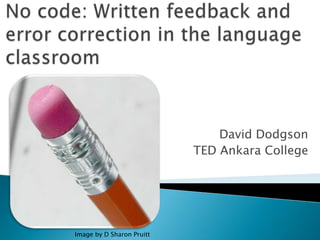No code written feedback & error correction in the language classroom
- 1. No code: Written feedback and error correction in the language classroomDavid DodgsonTED Ankara CollegeImage by D Sharon Pruitt
- 2. Which age groups do you work with?A. Pre-School/KindergartenB. Primary/Elementary SchoolC. Middle SchoolD. High School/University prepE. Adult learnersFirst, a quick poll...
- 3. Put your teacher¡¯s hat on...
- 4. Put your teacher¡¯s hat on...Sp?XGSp?W.O.GSp??Good but be careful with spelling!Remember: She goes NOT She¡¯s goes!!
- 5. Put yourself in the learners¡¯ shoes...Image by Maddy Lou
- 6. The end of the process?
- 7. Focusing on contentImage by toolstop
- 9. From my classroom...I really enjoyed reading about your best friend and I want to know more!Her favourite animal is a rabbit ¨C has she got a pet rabbit?She has got 1 or 2 fish ¨C goldfish? Has she got an aquarium?She goes to Charles de Gaulle ¨C is she French? Or can she speak French?Please tell me more!
- 10. A part of the process, not the end
- 11. What about error correction?Image by Mad African
- 12. Why ¡®no code¡¯?
- 13. Why ¡®no code¡¯?
- 14. A collaborative solutionImage by ToGa Wanderings
- 15. A collaborative solutionCreate a paragraph using common errors made by your students.Put them in groups of 3 or 4 and ask them to identify and correct the mistakes.Can be done on computer via typewith.me, google docs, etc.Or just do it on the board with different coloured markers!Make sure they review their own work afterwards and look for similar mistakes.
- 16. Doesn¡¯t it all take a lot of time (preparation and class time)?Yes, but it¡¯s worth it!Can kids really think critically in this way?You¡¯d be surprised!During collaborative error correction, don¡¯t they use a lot of L1?Yes, but so what? ?Questions I¡¯m often asked...
- 17. Let it grow...Image by Langwitches


















